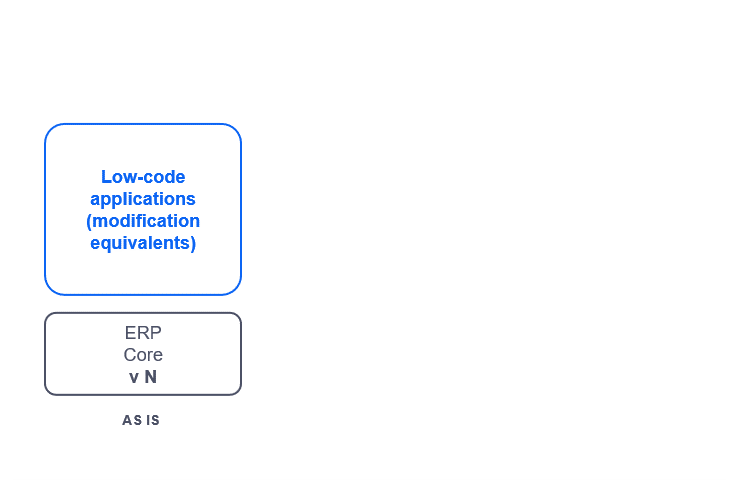 December 12, 2024
December 12, 2024  9 min to read
9 min to read What is a Low-Code Platform?
A low-code platform is a software tool that lets you create applications with minimal coding. Instead of writing complex code, users can use simple drag-and-drop features, visual interfaces, and pre-built templates to build apps quickly.
Low-code platforms are great for businesses because they allow people without advanced programming skills to create, modify, or improve software. This makes it faster and easier to develop solutions that fit specific needs while saving time and reducing costs.
Challenges Related to ERP Systems
At Novacura, we have over 15 years of experience in implementing and enhancing various ERP systems, leveraging our low-code integration platform. Throughout our work, we’ve noticed that regardless of the ERP system a company utilizes, there are common challenges that many organizations encounter. In this article, we summarize the key challenges related to ERP systems that our customers often face.
Complexity for Users
ERP systems are advanced and encompass numerous modules that provide hundreds of capabilities. However, they also introduce a degree of complexity, which can present challenges with ERP implementation. The wide range of available functions gives users flexibility but does not guide them in following the correct path to accomplish their tasks. As a result, seemingly simple tasks (such as creating a new customer in the system) may require several additional steps to be completed by the user before they can finalize the task. Users must be aware of these additional steps; otherwise, they will be unable to complete their work successfully.
Limited Integration Capabilities
Complexity is not the only drawback of ERP solutions. These platforms are primarily designed to serve as central points within the IT landscape. Other applications need to integrate with ERP solutions to communicate effectively. However, ERP systems typically do not provide ready-to-use connectors for third-party software. Instead, they offer APIs, leaving the integration to the other applications. As a result, connecting an ERP solution with a new third-party tool is not straightforward; customers cannot simply select a connector from the ERP marketplace, establish a connection, and start using it.
Limited Customization
Another issue with ERP systems is that they are designed for multiple companies across different industries within the same version. Although they offer a wide range of configuration parameters, they cannot be perfectly tailored to the specific needs of each organization. This creates a gap between the actual processes within a company and the fragmented processes supported by the ERP system. As a result, employees often resort to workarounds and begin operating outside the ERP by using Excel sheets, emails, and paper documents.
Expensive Modifications
To address the issue of relatively limited customizations, ERP vendors allow customers to create modifications to the software. However, these modifications often lead to complications and contribute to ERP implementation challenges. Since they are not separate from the ERP core, the entire architecture becomes more complex, making it difficult to identify and track all modifications. This is especially crucial during upgrades, as all altered components of the previous ERP version must be identified, documented, and typically rewritten in the new version.
Mobility
Modern ERP solutions, such as IFS Cloud, provide user interfaces that are optimized for mobile devices like smartphones and tablets. However, in practice, not all features are accessible on these devices. For instance, applications intended for mobile technicians or those working in warehouses and on shop floors are often underdeveloped and offer very limited functionality. Additionally, these mobile applications tend to mirror the complexity of the main ERP user interface, making them cumbersome to use.
No Process-oriented Thinking
ERP systems were initially designed to manage corporate resources. Different users can access different data, registers, assets, and transactions. They can read, modify, add, and delete this information. However, these operations are not part of a wider business process. The process is handled in the real world: when people receive a new task, they know how to process it in the ERP system, and they also know who to inform about it. Consequently, the next person—who is informed by email or call—can start their own task. However, the ERP system does not guide all users through the business process, leading to various ERP system challenges.
Solution: a low-code and integration platform connected to ERP system
At Novacura, we have been observing these challenges for many years. Therefore, 15 years ago, we decided to create our low-code platform, Novacura Flow, to help companies address the issues mentioned above. However, Novacura Flow is not just another low-code system; it is specifically designed to extend ERP systems. This means it offers, out of the box, the low-code platform advantages and benefits:
- Deep ERP integration philosophy
- Mobility
- Zero ERP modifications strategy support
- Integration platform capabilities
- Business process management (BPM) capabilities
What is a Low-code Platform?
A low-code development platform offers a visual interface, simple logic, and drag-and-drop features that enable users—even those without formal coding or software development knowledge—to create applications and build business processes independently. The benefits of low code include faster development times, reduced costs, and increased collaboration between IT and business teams.
With a low-code platform, users can design applications without formal coding training. The intuitive logic makes it easy for both the application creator and other business users within the organization to understand.
An example of an application designer in the low-code platform + final application look
What does Deep ERP Integration Mean?
Deep ERP integration means that the low-code platform is tightly connected with the ERP system. This integration is not merely an exchange of data at the end of a lengthy process. With deep integration in place, every change to business objects or transactions in the low-code environment should also be reflected in the corresponding objects and transactions stored within the ERP, following the rules defined by that ERP (via the API). All changes should be immediately visible within the ERP, even when using other ERP modules.
Deep ERP integration strategy
A deep integration strategy is effective only when a low-code platform provides a dedicated ERP connector that has access to all the APIs offered by that ERP. However, organizations often face challenges of implementing an ERP system. Therefore, the low-code application should continuously operate on data from the ERP.
Benefits of using a low-code platform connected to an ERP system
- Unlimited Customization – By storing changes in a low-code platform, you are no longer constrained by the customization rules set by the ERP system. You can do anything.
- 0-ERP Modifications Strategy – A low-code platform that supports deep ERP integration can implement a “zero ERP modifications strategy.” This means that all necessary modifications, which are typically made by directly altering the ERP system, are instead handled separately in the low-code platform. As a result, all low-code modification equivalents (low-code apps) are clearly identified, maintained in one place, and do not complicate the ERP architecture. This is particularly important during ERP upgrades; instead of rewriting old modifications for the new ERP version, low-code applications can simply be reconnected to the updated system. [Read more about it here.]

- Mobility – Modern low-code platforms provide a mobile interface, enabling users on smartphones and tablets to access all applications and data created within the platform. More advanced low-code platforms, such as Novacura Flow, offer dedicated mobile applications that can be installed on users’ devices. This approach allows low-code applications to leverage the full capabilities of mobile devices, including cameras, mobile printing, access to other IoT devices via Bluetooth Low Energy (BLE), and files stored on the device. Additionally, these applications can operate in offline mode, which is particularly beneficial for crews working outdoors, such as technicians.
- Easy User Interface – For regular users who require high efficiency in their daily operations, such as warehouse workers or shop floor operators, you can create dedicated and optimized applications that guide them step-by-step. This means operations are tailored to the optimal workflow, helping to increase overall efficiency. Moreover, the same process will be followed by new employees without the need for extensive training, as the application will only allow them to follow the prescribed path.
- Process Layer – Some low-code platforms enable the creation of a business process management (BPM) layer for your ERP system. This allows modifications and applications to be tailored for specific users, effectively replacing standard forms. Additionally, you can connect users across departments to facilitate collaboration. Editing master data can involve multiple users in the data change approval process, enhancing accuracy and accountability. [Read more about how to implement a BPM layer for your ERP].
- Integration Capabilities – Low-code platforms can serve as integration solutions, connecting your ERP system with data from other business systems. Many low-code platform providers offer pre-defined connectors, simplifying IT architecture and facilitating technical integrations. [Read more about the connectors available for Novacura FLOW].
- Technology Bridge – advanced low-code platforms (like Novacura FLOW) can be a bridge to the latest technologies – such as Artificial Intelligence (AI), Internet of things (IoT), and Augmented Reality (AR). These extensions can dramatically boost the value of your ERP system and improve overall work efficiency.
-
Citizen Development – Low-code platforms empower companies to adopt an innovative IT strategy known as citizen development. In this approach, everyday users learn to build applications without needing coding or software development expertise, enabling business users to take a more active role in the application creation process.
get a free demo:
Please fill out the form

Aksel Jarlbäck
Solution Expert
Summary
A low-code platform is an alternative to improve your BPM and make sure your ERP works with your business processes. This means that it can fill the gap between ERP systems and the actual business processes in a company.
With a low-code platform, you can connect your people, processes and technology exactly as you want to. Modifications can be kept separate from the ERP, which gives the possibility to re-connect instead of re-write modifications when upgrading your ERP.
To improve your BPM, a low-code platform is a good alternative also to avoid workarounds such as excel sheets, emails and paper documents. The simple logic of low-code allows users, not only those with coding experience, to create and manage and build their business processes themselves.





